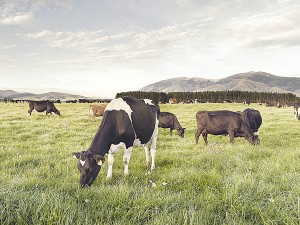University of Waikato research reveals 2050 drought threats
New research could help farmers prepare for a future where summer rainfall is increasingly unpredictable and where drought risk is rising, no matter what.
 Between 2022 and 2023, total emissions from agriculture decreased 2.2%, including a 1.6% drop in dairy cattle emissions.
Between 2022 and 2023, total emissions from agriculture decreased 2.2%, including a 1.6% drop in dairy cattle emissions.
Emissions by dairy cattle decreased by 1.6% according to the latest NZ Greenhouse Gas Inventory report.
It shows that between 2022 and 2023, total emissions from agriculture decreased 2.2% which included a 1.6% drop in dairy cattle emissions due to a fall in dairy cow numbers.
DairyNZ general manager Farm Solutions & Policy, Dr David Burger, says this is part of a trend that has seen methane emissions from dairy cattle decrease by 4.11% since 2017. He says DairyNZ statistics show a 3.4% decrease in cow numbers - from 4.84 million in the 2021/22 season to 4.67 million in the 2022/23 season.
“But at the same time, average milk production per cow increased over this same period by 1.8%, up to 393kgMS from 386kgMS,” he says.
Dr Burger says our dairy farmers continue to work hard to improve onfarm efficiency and their environmental footprint, with the report reflecting that. He says improved productivity in farming has enabled agricultural emissions to fall since 2014 and DairyNZ is supporting that through a dedicated programme of work focused sharply on productivity, resilience and sustainability.
“This includes our work to advocate for fair and achievable climate targets and our research into solutions for farmers to understand and manage their emissions,” he says.
Dr Burger says work being done includes a focus on forage species to understand their effect on baseline methane emissions and the response to other mitigation technologies in a pasture-based system. He says they are supporting different delivery mechanisms for getting methane solutions into our grazing systems, working to improve the accuracy of emissions accounting, including the inventory and helping farmers understand their on-farm greenhouse gas emissions.
“New Zealand dairy farmers are among the world’s most emissions efficient, and research is key to helping them maintain that position. DairyNZ is investing in research alongside a range of partners to develop and test different mitigation solutions, ensuring they are fit for use in our pasture-based systems,” he says.
Burger says DairyNZ supports the independent panel on methane recommendation that the 2050 target be adjusted to 14-15% to 24% instead of the 24-47% that is currently legislated.
“Our long-held position on climate targets is that they should reflect the latest science and warming impact of methane, while also considering the mitigation tools and technologies available to farmers,” he says.
Acclaimed fruit grower Dean Astill never imagined he would have achieved so much in the years since being named the first Young Horticulturist of the Year, 20 years ago.
The Ashburton-based Carrfields Group continues to show commitment to future growth and in the agricultural sector with its latest investment, the recently acquired 'Spring Farm' adjacent to State Highway 1, Winslow, just south of Ashburton.
New Zealand First leader and Foreign Affairs Minister Winston Peters has blasted Fonterra farmers shareholders for approving the sale of iconic brands to a French company.
A major feature of the Ashburton A&P Show, to be held on October 31 and November 1, will be the annual trans-Tasman Sheep Dog Trial test match, with the best heading dogs from both sides of the Tasman going head-to-head in two teams of four.
Fewer bobby calves are heading to the works this season, as more dairy farmers recognise the value of rearing calves for beef.
The key to a dairy system that generates high profit with a low emissions intensity is using low footprint feed, says Fonterra program manager on-farm excellence, Louise Cook.